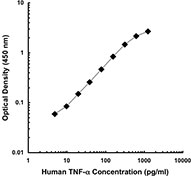- Regulatory Status
- RUO
- Other Names
- Tumor necrosis factor-α, Cachectin, Necrosin, Macrophage cytotoxic factor (MCF), Differentiation inducing factor (DIF), TNFSF2,
- Ave. Rating
- Submit a Review
- Product Citations
- publications
TNF-α is released from macrophages, monocytes, neutrophils, T-cells (principally CD4+), NK-cells and many transformed cell lines. Soluble homotrimeric TNF-α is released from cells by proteolysis of the integral membrane precursor form of TNF-α. TNF-α binding to some TNF-α receptors induces apoptosis and depending on cell type, receptor expression, and signal transduction status can induce other responses. TNF-α is involved in the inflammatory response.
Product DetailsProduct Details
- Source
- Human TNF-alpha, amino acids Val77-Leu233 (Accession # HUMTNFAB) was expressed in E. coli.
- Molecular Mass
- The 157 amino acid recombinant protein has a predicted molecular mass of 17,352 Da. The DTT-reduced and non-reduced protein migrates at approximately 16kDa by SDS-PAGE. The N-terminal amino acid is Val.
- Purity
- >98%, as determined by SDS-PAGE, Coomassie stained with Invitrogen SimplyBlue SafeStain.
- Formulation
- Lyophilized in sterile-filtered PBS, pH 7.2, containing 1% BSA, 0.09% sodium azide, and protease inhibitors.
- Endotoxin Level
- Less than 0.01ng per µg cytokine as determined by the LAL method.
- Concentration
- Lot-specific (to obtain lot-specific concentration and expiration, please enter the lot number in our Certificate of Analysis online tool.)
- Storage & Handling
- Unopened vials can be stored between 2°C and 8°C until the expiration date. Prior to use, reconstitute the lyophilized powder with 0.2 mL of PBS containing a carrier protein (e.g., 1% BSA, protease free), pH7.4. Re-cap vial, vortex. Allow the reconstituted standard to sit at room temperature for 15 minutes, vortex again to mix completely. The reconstituted standard stock solution can be aliquoted into polypropylene vials and stored at -70°C for up to one month. Do not re-use diluted standards. Avoid repeated freeze/thaw cycles.
- Application
-
ELISA
- Recommended Usage
-
Each lot of this protein is quality control tested by ELISA assay. For use as an ELISA standard, a standard curve comprised of doubling dilutions from 500 pg/ml to 4 pg/ml is suggested. It is recommended that the reagent be titrated for optimal performance for each application.
- Application Notes
-
ELISA: This TNF-a protein is useful as a standard for a human TNF-a sandwich ELISA, using unlabeled MAb1 antibody (Cat. No. 502802) for capture and biotinylated MAb11 antibody (Cat. No. 502904) for detection.
- Product Citations
-
Antigen Details
- Structure
- TNF superfamily; homotrimer
- Bioactivity
- Paracrine/endocrine mediator of inflammatory and immune functions; selectively cytotoxic for transformed cells; endothelial cell alterations; chemoattractant
- Cell Sources
- Activated monocytes, neutrophils, macrophages, T cells, B cells, NK cells, LAK cells
- Cell Targets
- Monocytes, neutrophils, macrophages, T cells, fibroblasts, endothelial cells, osteoclasts, adipocytes, astroglia, microglia
- Receptors
- TNFRSF1A (TNF-R1, CD120a, TNFR-p60 Type β, p55); TNFRSF1B (TNF-R2, CD120b, TNFR-p80 Type A, p75)
- Reconstitution
- Sterile phosphate-buffered saline is recommended.
- Biology Area
- Cell Biology, Immunology, Innate Immunity, Neuroinflammation, Neuroscience
- Molecular Family
- Cytokines/Chemokines
- Antigen References
-
1. Fitzgerald K, et al. Eds. 2001. The Cytokine FactsBook. Academic Press San Diego.
2. Beutler B, et al. 1988. Annu. Rev. Biochem. 57:505.
3. Beutler B, et al. 1989. Annu. Rev. Immunol. 7:625.
4. Tracey K, et al. 1993. Crit. Care Med. 21:S415. - Regulation
- Type II integral membrane protein processed by TACE for secretion; upregulated by interferons, IL-2, GM-CSF, substance P, bradykinin, PAF, immune complexes, cyclooxygenase; downregulated by IL-6, TGF-β, vitamin D3, prostaglandin E2, PAF antagonists,
- Gene ID
- 7124 View all products for this Gene ID
- UniProt
- View information about TNF-alpha on UniProt.org


















Follow Us